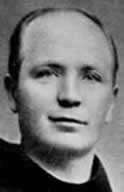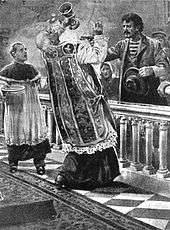Leo Heinrichs

Father Leo Heinrichs, O.F.M. (August 15, 1867, Oestrich, now a part of the city Erkelenz, Kingdom of Prussia - February 23, 1908, Denver, Colorado, United States) was a Roman Catholic priest of the Franciscan Order. While assigned to St. Elisabeth of Hungary Church in Denver, Colorado, Father Heinrichs was fatally shot while distributing communion. The shooter, a Sicilian Anarchist later described his motivations as hatred of Catholicism.
Biography
Joseph Heinrichs was born on August 15, 1867, in Oestrich, near Erkelenz, Westphalia, Germany.
Under persecution from Otto von Bismarck's Kulturkampf, the Franciscan Chapter of St. Elizabeth of Hungary fled their monastery in Fulda and settled at St. Bonaventure's Friary in Paterson, New Jersey. Although still studying in minor seminary, Joseph Heinrichs emigrated to America with them. In New Jersey, on December 4, 1886, Joseph Heinrichs received the Franciscan habit and the monastic name Brother Leo. He took his final vows on December 8, 1890, and was ordained to the priesthood on July 26, 1891.
Between 1891 and 1907, Father Leo served in various positions in the New York and New Jersey area including pastor at Holy Angels parish in Singac (Little Falls), New Jersey, at St. Stephen's in Croghan, New York,[1] and at St. Bonaventure's. During a smallpox epidemic in Paterson, Father Leo was known to spend many hours at a nearby “pest house” ministering to the sick and the dying. In September 1907, after the Provincial Chapter, the Minister Provincial appointed him pastor of St. Elizabeth's parish in Denver, Colorado.
Father Leo arrived at St. Elizabeth's on September 23, 1907. His term as pastor lasted exactly five months. Father Leo received permission to return to Germany to visit his family after an absence of over twenty one years; but he postponed his journey until after June 7, 1908, when he planned to give First Communion to a class of seventy children. A week before his death, he spoke at the Young Ladies' Sodality meeting. He remarked, “If I had my choice of a place where I would die, I would choose to die at the feet of the Blessed Virgin.”[2]
Death

Father Leo normally celebrated the 8am Sunday Mass, but he requested to switch to the 6 a.m. Mass, normally celebrated by Father Wulstan Workman. Father Leo had intended to attend a meeting later that morning. Among those attending the Mass was fifty-year-old Giuseppe Alia, an unemployed shoemaker[3] who had recently emigrated from Avola, Sicily. Alia arrived before Mass and seated himself in the third row, in front of the pulpit. It was a 6 a.m. “Workingmen's Mass”, and there was only a short sermon so the men would not be late for work.[2]
During Communion, Alia knelt at the Communion Rail and received the Eucharist. Then, Alia spat it into his hand and flung it at Father Leo's face. The Host dropped to the floor as Alia drew his revolver and aimed it at Father Leo's heart. An altar boy screamed, "Look out, Father!" Then, Alia opened fire. The mortally wounded priest exclaimed, "My God, my God!", before falling to the floor. Before dying, he placed the ciborium on the step of Our Lady’s altar, and managed to place two fallen Hosts back into the ciborium before strength left him. In a last gesture, Father Leo pointed to the spilled Hosts that he was now too weak to pick up. Rose Fisher, an eyewitness, reported that Father Leo died smiling, at the foot of the Blessed Virgin's altar.
According to Deacon William Joyce, "The coroner found that Father Leo's upper arms and waist were wrapped in leather straps. Each strap was studded with rows of pointed iron hooks, which pierced the skin. Around the priest's waist the skin was calloused and scarred, but showed no sign of infection. Father Leo secretly practiced this extreme form of mortification, perhaps to help him master his temper. None of his confrères had any idea of his self-inflicted penances. When the friars entered Father Leo’s room after his death, they found that he slept on a wooden door."[4]
Father Wulstan Workman, who had switched with Father Leo for the later Mass, administered the Last Rites. Father Wulstan told the Denver Post, "I would have been killed and he would be alive now. There is one way to solve the affair that I can see, and that is that God chose the better man."[4]
Legacy
Following his murder, the body of Father Leo Heinrichs was transported by rail to St. Bonaventure's Monastery in Paterson, New Jersey. Thousands of people, including large numbers of non-Catholics, attended his wake and requiem mass. Father Leo was then buried in Totowa, New Jersey's Holy Sepulchre Roman Catholic Cemetery.[5] Father Leo Heinrichs rests in the same cemetery as Father Mychal Judge, a fellow Holy Name Province Franciscan who was killed in the September 11th terrorist attacks.
Father Leo's cause for beatification was opened in 1938 and his grave continues to be visited by pilgrims.
Saint Elizabeth of Hungary parish continues to serve the Roman Catholic Church,[6] while also ministering to Denver's Russian Catholics.
In his native city of Erkelenz, there is a street named for Fr. Leo Heinrichs.[7]
Alia's arrest, trial, and execution
After fatally shooting Father Leo, Giuseppe Alia attempted to flee St. Elizabeth's Church. However, a parishioner, E.J. Quigley, a conductor for the Denver & Rio Grande Railroad, tripped him. Daniel Cronin, an off-duty Denver police officer, then followed the Sicilian to the church steps and attempted to arrest him. After a struggle over Alia's revolver, Cronin overpowered the murderer and delivered him to the city jail.
At the police station, Alia said,
"I went over there because I have a grudge against all priests in general. They are all against the workingman. I went to the communion rail because I could get a better shot. I did not care whether he was a German priest or any other kind of priest. They are all in the same class. I left Italy three months ago and went first to Central America, and then came to Denver. I am an Anarchist, and I am proud of it. I shot him, and my only regret is that I could not shoot the whole bunch of priests in the church."[8]
The people of Denver were enraged by Alia's actions and there was even talk of storming the city jail and lynching him. With this in mind, Denver law enforcement transported Alia to Colorado Springs for his own protection.
Based upon eye-witness testimony and his own confession, Alia was convicted of first degree murder and sentenced to death by hanging within weeks of the shooting. Alia never expressed any remorse and made two escape attempts from death row. The first involved the attempted murder of a prison trustee and the second of the prison's deputy warden. In both cases, however, Alia was overpowered by corrections officers soon after leaving his cell. Denver police officers expressed a belief, however, that local anarchists had smuggled the knives Alia had used into the Colorado State Penitentiary.
Following Alia's first escape attempt, the Italian Consul, Baron Gustavo Tosti, was interviewed. The Baron expressed a belief that Alia's behavior proved him to be mentally deranged. Even so, the Baron declared, "I have no intention of appealing to the Italian Government, or of trying to make this an international affair. It is purely a local case."[9]
Despite the pleas of the Franciscan Order, Giuseppe Alia was hanged on July 15, 1908 at the Colorado State Penitentiary in Cañon City. The Washington Herald reported Alia's execution as follows,
"He went to the gallows fighting, biting, and snarling. The night noises of the penitentiary had died away, when Warden Cleghorn summoned the murderer from his cell, and through an interpreter, told him that the hour of his death had arrived. Alia stood for just a moment glaring at the warden and the attendants. Then he raised his head, uttered a string of oaths, and offered his best physical resistance to accompanying the guards to the gallows. The murderer was held by the warden's assistants until he had exhausted himself; then he was supported to the trap, where the noose was adjusted and he was hanged."[10]
References
- ↑ Father Leo left his mark Franciscan rebuilt Croghan parish, and a case was built for sainthood," Watertown Daily Times, October 10, 2010.
- 1 2 Fr. Leo Heinrichs, O.F.M.
- ↑ New York Times, February 24, 1908.
- 1 2 "Leo Heinrich, O.F.M.". Five Franciscan Martyrs Region Secular Franciscan Order.
- ↑ All Creeds Honor Murdered Priest, New York Times, March 2, 1908
- ↑ St. Elizabeth of Hungary parish (Denver, Colorado) website
- ↑ Leo-Heinrichs-Weg in D-41812 Erkelenz
- ↑ New York Times, February 24, 1908
- ↑ New York Times, March 15, 1908.
- ↑ Washington Herald, July 16, 1908, Page 1.
External links
- Find A Grave's Page on Father Leo Heinrichs
- Commemorative page of Fr. Leo Heinrichs (with photos of him, his tomb and the church where he was shot)
- "PRIEST SHOT DEAD AT COMMUNION RAIL; Anarchist Glories in Crime", New York Times, February 24, 1908
- "Trial of Priest's Slayer: Alia, who shot Father Leo of Denver, will be in court today. New York Times, March 9, 1908.
- "Father Leo's slayer guilty", New York Times, March 13, 1908
- "ALIA SLASHES GUARD, ATTEMPTS ESCAPE", New York Times, March 15, 1908.
- "ALIA FELLS HIS GUARD.; Slayer of Father Leo Makes His Second Attempt at Escape." New York Times, June 14, 1908.
- Memorial Booklet for Father Leo Heinrichs, Digital Collections, Denver Public Library
- Luigi Botta, Un calzolaio sul patibolo (Giuseppe Alia), "America Oggi", 30 marzo 2016